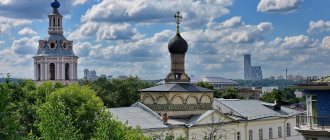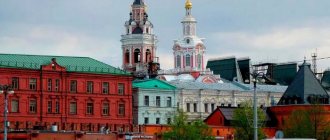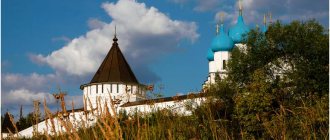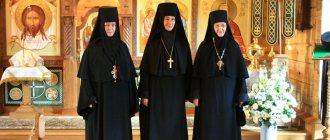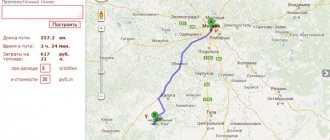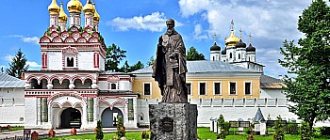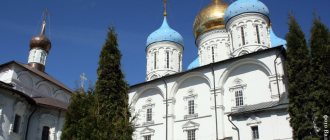Mir
Russia Moscow Novospassky Monastery (Moscow) Map loading in progress...
{"format":"leaflet","minzoom":false,"maxzoom":false,"limit":50,"offset":0,"link":"all","sort":[""], "order":[],"headers":"show","mainlabel":"","intro":"","outro":"","searchlabel":"\u2026 \u0441\u043b\u0435\ u0434\u0443\u044e\u0449\u0438\u0435 \u0440\u0435\u0437\u0443\u043b\u044c\u0442\u0430\u0442\u044b","default":"","import-annotation":false,"width ":"auto","height":"350px","centre":{"text":"","title":"""link":"""lat":55.73151899999999869805833441205322742462158203125,"lon": 37.657882999999998219209373928606510162353515625,"icon":""},"title":"","label":"","icon":"","lines":[],"polygons":[],"circles":[ ],"rectangles":[],"copycoords":false,"static":false,"zoom":8,"defzoom":14,"layers":["OpenStreetMap"],"image layers":[] ,"overlays":[],"resizable":false,"fullscreen":true,"scrollwheelzoom":true,"cluster":false,"clustermaxzoom":9,"clusterzoomonclick":true,"clustermaxradius":80, "clusterspiderfy":true,"geojson":"","clicktarget":"","showtitle":true,"hidenamespace":false,"template":"","userparam":"","activeicon": "","pagelabel":false,"ajaxcoordproperty":"","ajaxquery":"","locations":[{"text":"\u003Cb\u003E\u003Ca href=\"/palomnik/%D0% 9D%D0%BE%D0%B2%D0%BE%D1%81%D0%BF%D0%B0%D1%81%D1%81%D0%BA%D0%B8%D0%B9_%D0%BC% D1%83%D0%B6%D1%81%D0%BA%D0%BE%D0%B9_%D0%BC%D0%BE%D0%BD%D0%B0%D1%81%D1%82%D1% 8B%D1%80%D1%8C_(%D0%9C%D0%BE%D1%81%D0%BA%D0%B2%D0%B0)\» title=\»\u041d\u043e\u0432\u043e\ u0441\u043f\u0430\u0441\u0441\u043a\u0438\u0439 \u043c\u0443\u0436\u0441\u043a\u043e\u0439 \u043c\u043e\u043d\u0430\u0441\u0 442\u044b\u0440\u044c (\u041c \u043e\u0441\u043a\u0432\u0430)\»\u003E\u041d\u043e\u0432\u043e\u0441\u043f\u0430\u0441\u0441\u043a\u0438\u0439 \u043c\u044 3\u0436\u0441\u043a\ u043e\u0439 \u043c\u043e\u043d\u0430\u0441\u0442\u044b\u0440\u044c (\u041c\u043e\u0441\u043a\u0432\u0430)\u003C/a\u003E\u003C /b\u003E\u003Chr/ \u003E\u003Ca href=\»/palomnik/%D0%A1%D0%B2%D0%BE%D0%B9%D1%81%D1%82%D0%B2%D0%BE:%D0%90%D0 %BD%D0%BD%D0%BE%D1%82%D0%B0%D1%86%D0%B8%D1%8F\" title=\"\u0421\u0432\u043e\u0439\u0441\u0442\u0432 \u043e:\u0410\u043d\u043d\u043e\u0442\u0430\u0446\u0438\u044f\»\u003E\u0410\u043d\u043d\u043e\u0442\u0430\u0446\u0438\u044f \u003C/a\u003E: »'\u041d\u043e\u0432\u043e\u0441\u043f\u0430\u0301\u0441\u0441\u043a\u0438\u0439 \u043c\u043e\u043d\u0430\u0441\u0442\u044b \u0301\u0440\u044c»' 2014 u0433\u0438\u0430\u043b\u044c \u043d\u044b\u0439 \u043c\u0443\u0436\u0441\u043a\u043e\u0439 \u043c\u043e\u043d\u0430\u0441\u0442\u044b\u0440\u044c \u0420 \u0443\u0441\u0441\u043a\u043e \u0439 \u043f\u0440\u0430\u0432\u043e\u0441\u043b\u0430\u0432\u043d\u043e\u0439 \u0446\u0435\u0440\u043a\u0432\u0438, \u044 0\u0430\u0441\u043f\u043e\ u043b\u043e\u0436\u0435\u043d\u043d\u044b\u0439 \u0432 \u041c\u043e\u0441\u043a\u0432\u0435 \u0437\u0430 \u0422\u0430\u0433\ u0430\u043d\u043a\u043e\u0439, \u043d\u0430 \u041a\u0440\u0443\u0442\u0438\u0446\u043a\u043e\u043c \u0445\u043e\u043b\u043c\u0435, \u0443 \u0431\u0435\u04 40\u0435\u0433\u0430\u041c\ u043e\u0441\u043a\u0432\u044b-\u0440\u0435\u043a\u0438. \u0418\u0437\u0432\u0435\u0441\u0442\u0435\u043d \u0441\u0432\u043e\u0435\u0439 \u0442\u0435\u0441\u043d\u043e\u0439 \u0441 \u0432\u044f\u0437\u044c\u044e \u0441 \u0440\u043e\u0434\u043e\u043c \u0420\u043e\u043c\u0430\u043d\u043e\u0432\u044b\u0445","title":"\u041d\u043e\u0432\u043e\ u0441\u043f\ u0430\u0441\u0441\u043a\u0438\u0439 \u043c\u0443\u0436\u0441\u043a\u043e\u0439 \u043c\u043e\u043d\u0430\u0441\u0442\u044b\u0 440\u044c (\u041c\u043e\u0441 \u043a\u0432\u0430)","link":"","lat":55.73151899999999869805833441205322742462158203125,"lon":37.65788299999999821920937392860651016 2353515625,"icon":""}],,"imageLayers":[]}
55.731247; 37.657574
Russia, Moscow, Krestyanskaya square, 10с2
Moscow
Russia
Telephone:
(495) 676-95-70
Email:
Novospassky Monastery
- a historically stavropegic monastery of the Russian Orthodox Church, located in Moscow beyond Taganka, on Krutitsky Hill, near the banks of the Moscow River. Known for his close connection with the Romanov family. The architectural ensemble was formed in the 17th-18th centuries.
History[[edit]h2>
Founded in 1490 in the name of the New Savior by Grand Duke Ivan III, who transferred the brethren of the Kremlin Monastery of the Savior on Bor out of the city. The latter arose around 1330 under the Grand Duke Ivan Kalita.
Photo from the “Collection of Landmarks of the Russian Empire”, 1911-1912.
The first stone Cathedral of the Transfiguration was built in 1494. The monastery began to enjoy the royal favor and acquire a modern appearance after the Romanov family came to power, whose family tomb had long been located in the Novospassky Monastery. In 1646-1649, the future Patriarch Nikon was the archimandrite of the Novospassky Monastery.
The monastery was closed in 1918 and in the same year a concentration camp was set up on its territory. Monastery monuments of museum significance were assigned to the Simonov Monastery Museum. In the 1920s, the architect S.K. Rodionov carried out restoration of the monastery buildings. In 1925, the territory of the monastery was occupied by the Second Women's Correctional Home. The monastery cemetery was demolished in 1927-1930.
Since 1935, the territory of the monastery was in charge of the economic administration of the NKVD. All monastery buildings were converted for economic needs or for housing. The eviction of tenants began in 1960. In 1968, it was decided to organize a “museum of the history and modern practice of restoration work in the USSR” on the basis of the monastery.
Restoration work dragged on for many years. It was planned to open a Museum of the History of Restoration in the cathedral. A large restoration center on the territory of the monastery existed from 1985 until the end of 1990, when it was decided to return the monastery to the Moscow Patriarchate.
See also:
Novospassky Monastery in Moscow (1863, 89 pages)
Island of salvation
On the territory of the Novospassky Monastery there are 6 cathedrals, a bell tower, towers and chapels, a fraternal building and a utility yard.
Social significance
Symposiums are held here, and a publishing house has been created that produces religious and educational literature.
Each issue of the magazine highlights a moral theme: courage and freedom, justice and love, victory, patience and struggle. The work of the monastery website, Sunday school and youth association is subject to instruction in the Orthodox Christian faith. The Sunday school, which has been operating for 20 years, has 7 age groups. Here the hearts of children are nurtured, they strive to raise a Christian - kind, merciful, sympathetic, sympathetic.
The work of the youth association “Young Russia” is based on the initiatives of its participants, whose main desire is the desire to be together with their Orthodox peers. The events are open and anyone can join them.
The monastery annually hosts a charity Christmas fair and operates two humanitarian collection and distribution points for clothing and shoes for the poor and homeless. Work is systematically carried out to provide assistance to alcohol and drug addicts.
A church singing school for boys was opened at the monastery. The famous Novospassky men's choir is the calling card of the monastery. Fans call the choir the voice of Russian monasticism.
Monastery Garden
The territory of the monastery is very well-groomed. The Romanov dynasty sought to ensure that roses grew in the monastery. Over the past 20 years, a beautiful garden has been created in the Novospasskaya monastery, in which only 2 gardeners work. Thick walls have created a unique microclimate here: the 600 rose bushes grown in the garden are selected so that they bloom from early spring to late autumn. Flower beds are decorated with crocuses and tulips, jasmine and magnolias. A rare white-pink variety of lilac exudes a delicate aroma.
Apple trees, cherries, and black rowan trees are bursting under the weight of fruit. The apricots, peaches and grapevines that ripen in time for the Feast of the Savior are amazing in the garden. A fruit plantation was planted on the site of a necropolis destroyed during Soviet times. Squirrels live in a special enclosure.
Monastic work
Most of the brethren of the monastery are Muscovites. The ancient monastery lives the usual monastic routine, in which prayer and work are combined. Monks pray for the whole world. Every day and hour of the monk is built on obedience, which is placed above fasting and prayer.
There are jewelry, carpentry and weaving workshops . Fabrics made here decorate the country's theaters. The “Pilgrim” refectory and the food stall next to the refectory amaze with their abundance. Here are herbal collections, numerous varieties of oils, gingerbread and chocolate, honey and dried fruit candies. Yeast-free bread according to the monastery recipe is popular. Loaves baked overnight are sold out in the morning while still warm.
Divine services are held daily at the Novospassky Monastery, which attract hundreds of parishioners, tourists and pilgrims. People come to the monastery to venerate the miraculous icons and touch the ancient shrines. People bring illnesses, sorrows, a heavy burden of guilt and resentment here. Anyone who comes with sincere faith and a need for help receives it in the form of relief and strengthening of mental strength, and often physical healing.
Here you want to believe in the justice of the world order, put aside frustration and bitter irony, stop for a moment amid the bustle and take a deep breath, even cry. I want to smile at the flowers, the fluffy Christmas trees, the clean cat - after all, this is the abode of victorious goodness and peace, an island fenced off by high walls from the noisy city.
Current state[[edit]h2>
The revival of monastic life began in April 1991. In July of the same year, the men's choir of the Novospassky Monastery was created.
In 1995, the ashes of Grand Duke Sergei Alexandrovich, who was killed 90 years earlier by terrorist Ivan Kalyaev, were transferred here. A memorial cross was erected on the territory of the monastery, recreated according to the surviving design of Viktor Vasnetsov - an exact copy of the monument that existed in the Kremlin.
In February 2014, Patriarch Kirill consecrated the 16-ton “Romanovsky” bell, which was cast to replace the historical bell destroyed in the 20th century.
On February 5, 2015, the relics of the Holy Great Martyr Demetrius of Thessalonica - the incorruptible right hand - were brought to the monastery from Greece. The bringing of the ark with the relics of the saint is dedicated to the 70th anniversary of the victory over fascism: in Rus', the memory of St. Demetrius of Thessalonica has been associated since ancient times with military feats, patriotism and defense of the Fatherland.
Abbots, governors
- John I (1330 - 1346)
- Peter (1346 - 1353)
- John II (Nepean) (1353 - 1374)
- Mikhail (Mityai) (1375 - 1377)
- Simeon (1382 - 1382)
- Sergius I (1389 - 1389)
- Ignatius (1389 - 1404)
- Theodosius (1404 - 1404)
- Matthew (1404 - 1404)
- Hilarion (1406 - 1406)
- Savva (1410 - 1410)
- Tryphon (1453 - 1462)
- St. Vassian I (Snout) (1466 - 1468)
- Herman (1474 - 1474)
- Elisha (1483 - 1488)
- Athanasius I (Generous) (1496 - 1515)
- Savva (1526 - 1530)
- Theodosius (1539 - 1542)
- Nifont I (Kormilitsyn) (1543 - 1554)
- Nikephoros (1554 - 1558)
- Galaktion (1558 - 1565)
- Anthony (1565 - 1568)
- Vassian II (1569 - 1575)
- St. Job (1575 - 1581)
- Joachim (1581 - 1589)
- Sergius II (1589 - 1589)
- Sylvester (1589 - 1598)
- Zacchaeus (1598 - 1599)
- Sergius III (1599 - 1606)
- Euthymius I (1610 - 1613)
- Joseph I (1613 - 1619)
- Niphon II (1623 - 1623)
- Lawrence I (1627 - 1629)
- Mitrofan (1629 - 1629)
- Tikhon I (1630 - 1631)
- Joseph II (1631 - 1637)
- Lawrence II (1638 - 1638)
- Jonah (1639 - 1645)
- Nikon I (Minich or Minov) (1646 - 1649)
- Nikon II (1649 - 1654)
- Pitirim (1654 - 1655)
- Sergius IV (1656 - 1656)
- Joseph III (1658 - 1663)
- Prokhor (1663 - 1664)
- Joseph IV (December 22, 1664 – August 9, 1674)
- Niphon III (1674 - 1697)
- Macarius I (1674 - 1681)
- Gabriel I (Kichigin) (1681 - 1684)
- Ignatius (Rimsky-Korsakov) (1684 - 1692)
- Tikhon II (Voinov) (April 3, 1692 - April 21, 1695)
- Triphyllius (Inichov) (May 4, 1695 - May 17, 1697)
- Isaiah (1697 - July 23, 1699)
- Hilarion I (1699 - 1701)
- Hilarion II (Sovereign) (1701 - 1702)
- Joasaph II (1702 - 1710)
- Dosifey (Glebov) (1710 - 1711)
- Moses (1711 - 1714)
- Arseny (1715 - 1716)
- Sergius V (1716 - 1720)
- Hierotheus (Prilutsky) (1721 - 1728)
- Euthymius II (Colleti), Greek (1728 - 1730)
- Theophilus (1730 - 1732)
- Hilarion II (1733 - 1735)
- Nikodim (Skrebnitsky) (February 1736 - 1738)
- Anthony (Ilyashevich) (1739 - 1748)
- Gabriel II (Kremenetsky) (April 5, 1748 - 1749)
- Misail (Chirsky) (1749 - August 17, 1764 [1[1]/li>
- Cyril I (Lyashevetsky) (April 17 - August 6, 1758 [2[2]/li>
- Simon (Lagov) (1764 - 1769)
- John III (Cherepanov) (1770 - 1778)
- Joasaph III (Maslov) (1779 - 1785)
- Pavel (Ponomarev) (January 14, 1786 - 1794)
- Methodius (Smirnov) (February 14, 1794 - 1795)
- Ambrose I (Yakovlev-Orlin) (1795 - 1796)
- Anastasy (Bratanovsky-Romanenko) (1796 - 1797)
- Iakinf (Karpinsky) (1797 - 1798)
- Varlaam (Golovin) (1799 - 1811)
- Sergius VI (Krylov-Platonov) (June 14, 1811 - 1812)
- Ambrose II (Ornatsky) (1812 - 1816)
- St. Filaret (Drozdov) (March 1816 - 1819)
- Kirill II (Bogoslovsky-Platonov) (1819 - 1824)
- Polycarp (Goitannikov) (1824 - 1834)
- Apollos (Alekseevsky) (1834 - 1851)
- Agapit I (Voznesensky) (1851 - 1852)
- Agapit II (Vvedensky) (August 1852 - May 28, 1877)
- Porfiry (Uspensky) (1878 - April 19, 1885) bishop. b. Chigirinsky
- Peter (Ekaterinovsky) (August 9, 1885 - May 27, 1889) bishop. b. Tomsk
- Joseph (Chepigovsky) (July 22, 1889 - ?) bishop. b. Vladikavkazsky
- Nestor (Metaniev) (December 16, 1889 - January 29, 1894) bishop. b. Smolensky
- Anatoly (Stankevich) (January 29, 1894 - December 20, 1898) bishop. b. Kaluzhsky
- Kliment (Stoyanovsky) (1898 - 1906)
- Boris (Shipulin) (1906 - 1909)
- sschmch. Macarius II (Gnevushev) (1909 - 1914)
- Euthymius III (Eliev) (1914 - 1918)
- Kirill (Sokolov) (late 1917 - 1920)
- Palladium (Dobronravov) (1919 - 1922)
- sschmch. Peacock (Kroshechkin) (1920 - 1921)
- sschmch. Evgeny (Kobranov) (1921 - 1922)
- Alexy (Frolov) (March 1991 - March 22, 2011) archbishop. Kostroma
- Savva (Mikheev) (March 22, 2011 - July 14, 2018)
- Ioann (Rudenko) (July 14, 2021 - February 26, 2019)
- Dionysius (Porubai) (since February 26, 2019)
Architecture[[edit]h2>- The six-pillar Transfiguration Cathedral, huge for its time; built in 1645-1649. dependent on Tsar Mikhail Feodorovich; Guriy Nikitin was invited from Kostroma for painting.
- Church of the Intercession with a refectory (1670s)
- Walls and towers of the monastery 1640-1642. the buildings.
- Brotherly cells with St. Nicholas Church.
- Abbot's chambers at the turn of the 17th and 18th centuries.
- The bell tower is 78 meters high, one of the tallest in pre-revolutionary Moscow, built in 1759-1785. on the site of an ancient belfry, built in 1622 by Patriarch Filaret.
- Church of the Sign (1791-1795, architect E. Nazarov).
- Tomb of the Romanovs. In the basement of the Transfiguration Cathedral there is a number of graves, among which are the burials of the Zakharyin-Romanov boyars.
- Necropolis.
Plan of the monastery
In the basement of the Transfiguration Cathedral, the boyars Zakharyin-Koshkin, the ancestors of the royal house of the Romanovs, their relatives the princes of Sittsky, as well as the Cherkasy, Yaroslavl, Obolensky, Troekurov, Trubetskoy, Naryshkin and other representatives of the highest nobility of the pre-Petrine era are buried. The monument on the grave of V. D. Novosiltsev, designed by V. I. Demut-Malinovsky, was considered a masterpiece of memorial sculpture.
The Znamenskaya Church standing nearby is the family tomb of Counts Sheremetevs, Princes Kurakins and Lobanov-Rostovskys. In 1742, in the basement of the temple that previously stood on this site, State Chancellor A. M. Cherkassky was buried in the presence of Empress Elizabeth.
Within the monastery walls, a necropolis with a large number of aristocratic burials was formed in the 18th-19th centuries. The artist F.A. Rokotov, mayor N.A. Alekseev, historian P.P. Beketov, theatergoer I.A. Gagarin, Decembrist P.P. Titov were buried here.
Of historical interest was the grave of Priest Peter Venyaminov, who did not give up the monastery treasures to the soldiers of Napoleonic army and was killed by the French. An epitaph was engraved on his tombstone: “Here is modestly buried the altar server, a hero who tasted death - for his faith, for the king.” There are also allegations that it was on the territory of the Novospassky Monastery that the nun Dosifeya, the former princess Tarakanova, found her final refuge.
At the end of the 1920s, like other noble necropolises, the cemetery of the Novospassky Monastery was destroyed. The most valuable monuments from an artistic point of view were transported to the Donskoy Monastery; some of them were later sold for scrap. A small number of surviving tombstones are now on display in the monastery courtyard.
- Museum of the Novospassky Monastery
The Novospassky Monastery Museum was created for the 20th anniversary of the revival of the monastery. It was inaugurated on August 19, 2011. The museum is located on the site of the tomb.
Patronal holidays[[edit]h2>
Transfiguration
- August 19
Protection of the Blessed Virgin Mary
- October 14
December 10 is the celebration of the icon of the Mother of God “The Sign” - the patronal feast of the Znamensky Church. Currently, repair and restoration work is underway in this church. Divine services are not held in the temple.
On August 31, the Novospassky Monastery solemnly celebrates the icon of the Mother of God “Vsetsaritsa”. Her revered image has been in the Novospassky Monastery since 1995, located in the gallery of the Transfiguration Cathedral.
February 17 is the day of memory of Grand Duke Sergei Alexandrovich. On this day in 1905, the Grand Duke was killed at the hands of a terrorist. The remains of Grand Duke Sergei Alexandrovich in 1997 were reburied in the Novospassky Monastery in the tomb of the Romanov boyars. On February 17, according to tradition, a memorial service is held at the grave of the Grand Duke.
July 16 - July 17 are special days for the Novospassky Monastery. On this day, the Russian Orthodox Church commemorates the holy royal passion-bearers. The day before, a Romanov evening dedicated to the Romanov dynasty is held at the monastery. For a long time, the Novospassky Monastery was considered royal. Since the 15th century, the Romanov boyars were buried in the monastery. The Novospassky Monastery was visited three times by the Passion-Bearer Tsar Nicholas II. In the Novospassky Monastery, the so-called Italian courtyard, where executions were carried out during the Soviet years, is open to the public.
July 18 is the day of remembrance of the Holy Martyr Grand Duchess Elizabeth Feodorovna. More than once the Grand Duchess visited the Novospasskaya monastery. Her holy icon with a piece of her relics and a piece of her coffin resides in the monastery.
September 4 is the day of remembrance of the Hieromartyr Macarius (Gnevushev), Bishop of Oryol. In 1909-1914 he was the abbot of the Novospassky Monastery.
November 3 is the day of remembrance of the Holy Martyr Pavlin, Archbishop of Mogilev. Hieromartyr Pavlin (Kroshechkin) took monastic vows within the walls of the Novospassky Monastery.
On August 10, the Russian Orthodox Church celebrates the Icon of the Mother of God of Smolensk. The Novospassky Monastery houses the revered image of the Smolensk Icon of the Mother of God, a gift from the nun Martha.
Features of the monastery
Many people are interested in why the Novospassky Monastery is called stauropegial. This name is given to Orthodox monasteries, the cross in the altar of which was erected by the Patriarch himself. Such monasteries fall under the guardianship of the canonical administration of the head of the Russian Orthodox Church. The Patriarch appoints governors in these monasteries: archimandrite or abbess.
Stavropegic monasteries have a number of privileges. For example, they are given the right to self-government and gain a certain independence. Of the several hundred Orthodox complexes in Russia, only 25 monasteries are considered stauropegial. One of the monasteries with this special status is the Novospassky Monastery.
The Novospassky Monastery has an atmosphere of holiness and a unique microclimate. Apricot trees bear fruit here, and flowers of incredible beauty grow in the garden. Believers believe that the mercy of God descended on this Orthodox complex. The prayer for salvation performed in the monastery takes on a special meaning. Serving the Fatherland is perceived here as a continuation of the centuries-old traditions of our ancestors. Many of those who visited the monastery’s churches say that they experienced the inexplicable joy of prayerful presence.
Pilgrim[[edit]h2>
Excursion Service of the Novospassky Monastery
The excursion service staff conducts excursions on the following topics:
• Review of the architectural ensemble of the monastery.
• Review of the architectural ensemble with a visit to the Transfiguration Cathedral and the Tomb of the Romanov Boyars.
• Review of the exhibition of the Novospassky Monastery Museum.
• Tour of the ancient walls.
The excursion service of the Novospassky Monastery is open daily from 10.00 to 16.00.
You can order excursions, sign up for a group excursion and get additional information in the Excursion Service premises at the entrance to the monastery, as well as by phone:
or by writing to us
Current schedule of services
Divine service
Daily - hours and Liturgy at 8.00; Vespers and Matins at 17.00, on Sundays and holidays - Liturgy at 7.00 and 9.00, the day before - all-night vigil at 17.00. Every day (except for the weekdays of Great Lent), at the end of the Liturgy, there is a prayer service to the Mother of God before the icon “The All-Tsaritsa”; on Sundays there is a prayer service for the holy water.
The monastery has a courtyard with an active church of the Archangel Michael (address: 143397, Moscow region, Naro-Fominsk district, Pervomaisky village, Milyukovo village, Monastyrskaya street, building 20. 913-76-62).
